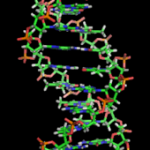It’s easy to get excited about the idea of encoding information in single molecules, which seems to be the ultimate end of the miniaturization that has been driving the electronics industry. But it’s also easy to forget that we’ve been beaten there—by a few billion years. The chemical information present in biomolecules was critical to the origin of life and probably dates back to whatever interesting chemical reactions preceded it.
It’s only within the past few decades, however, that humans have learned to speak DNA. Even then, it took a while to develop the technology needed to synthesize and determine the sequence of large populations of molecules. But we’re there now, and people have started experimenting with putting binary data in biological form. Now, a new study has confirmed the flexibility of the approach by encoding everything from an MP3 to the decoding algorithm into fragments of DNA. The cost analysis done by the authors suggest that the technology may soon be suitable for decade-scale storage, provided current trends continue.
via MP3 files written as DNA with storage density of 2.2 petabytes per gram | Ars Technica.


Pingback: viagra once daily()